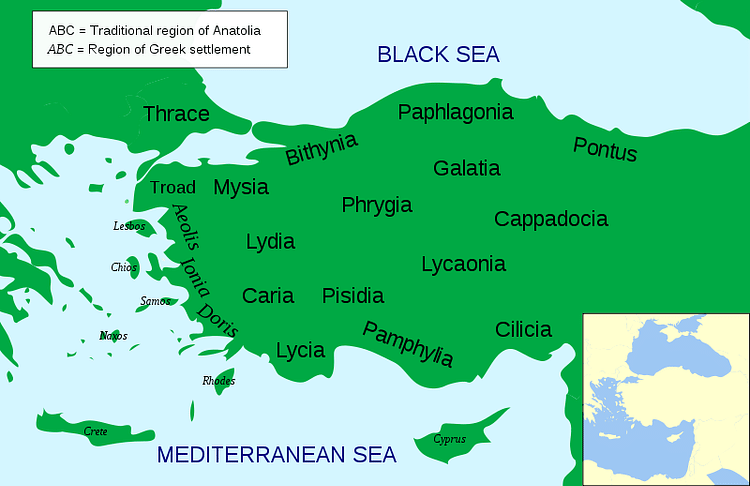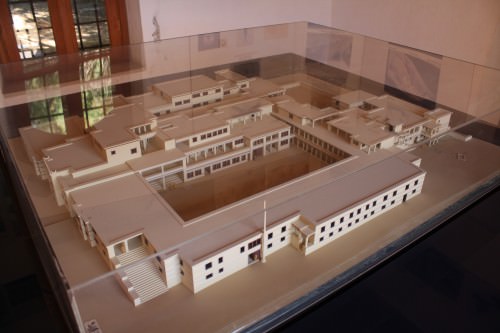Cilicia › Minoan Architecture » Ancient origins
Articles and Definitions › Contents
- Cilicia › Antique Origins
- Minoan Architecture › Antique Origins
Ancient civilizations › Historical and archaeological sites
Cilicia › Antique Origins
Definition and Origins

The region of Cilicia is located in the southern part of Anatolia. Located on an active Mediterranean trade route, Cilicia is generally associated with its area of native rebellion and piracy. Cilician pirates particularly dominated between 133 and 67 BCE when they were defeated by Pompey the Great. Pompey revolutionised warfare at this time by offering the pirates a peaceful chance to surrender and receive leniency.
Cilicia is surrounded by a natural fortress provided by the Taurus Mountains to the North and East and the Mediterranean on the South with a coast full of ideal hiding places for pirates. Archaeological features in many areas include mooring, construction of buildings and shore access, stairs, defensive walls, fortresses, submerged columns, anchor remains and shipping jars, indicative of a coastal culture. Within Cilicia are two sub-regions known as Flat/Smooth Cilicia or Cilicia Pedias (the Eastern region), and Rough Cilicia or Cilicia Tracheia. Evidence from the 13th century BCE indicates that the region was originally called Kedi/Kode before the fall of the Assyrian Empire in the 7th century BCE when it became an independent region ruled by the Syennesis dynasty of kings and then being absorbed into the Persian Empire by Cyrus the Great.
The pirate attacks in Cilicia appear to originally have been directed against Seleucid Kings involving slave and wine trade before they became more indiscriminate at the end of the 2nd century BCE and defensive walls were built. Rome thus implemented an official ban of pirate interactions in 102-100 BCE and created the Roman province of Cilicia to legitimise these laws. The general M.Antonius was commissioned to curb the pirate menace while the pirates allied themselves to the King of Pontus, Mithridates, to fight against Roman dominance. Eventually they were defeated by Pompey and Mithridates committed suicide in 63 BCE. With this, the Pontic kingdom also became a Roman province attached to Bithynia. The death of Julius Caesar saw some minor pirate wars in succeeding years but these were easily curbed.
At one point Cilicia was gifted to Cleopatra VII by Anthony but with their deaths it was again split up and handed over in part to Antiochis IV of Commagene. While older tribes such as the Cetae, Lalasseis and Cennatae stayed settled in certain areas of Cilicia, Cilicia then became two Byzantine provinces; Cilicia Prima and Secunda.
Minoan Architecture › Antique Origins
Definition and Origins

The unique contribution of the Minoan civilization to European architecture is possibly most evident in the great palace structures of the major Minoan centres of Knossos, Phaistos, Malia and Zakros. Perhaps influenced by Egypt and the Near East and evolving through the monumental tombs of the preceding period, these magnificent buildings, constructed from c. 2000 BCE to c. 1500 BCE, were so complex and ahead to such a degree of the architectural standards at that time that, at Knossos at least, they may even have been the original source of the Labyrinth myth, such would have been their effect on the casual visitor.
MINOAN PALACES
Whilst the word 'palace' is commonly used to refer to these Minoan centres, one must be wary of such modern connotations as 'political' and 'centralised power' which the word 'palace' implies. The Minoan complexes were large and well-appointed, they included large public areas and had extensive storage magazines but the archaeological evidence is, at present, not sufficiently conclusive to state definitely that these palaces were the seat of a central religious/political ruler or ruling body.However, it is fair to say that the presence of a large numbers of seals, tablet archives, pithoi and amphorae and the space dedicated to storage (over one third of the site) would suggest that the palaces were the centre of some sort of centralised commerce and trade, both local and foreign. In addition, the very size and splendour of the buildings would suggest the necessity for a certain centralized planning, artisan, and materials organisation.
THE STRIKING FEATURE OF THE MINOAN MONUMENTAL PALACES IS THEIR OVERALL SIZE, COVERING SEVERAL THOUSAND SQUARE METRES.
The striking feature of the monumental palaces is their overall size, covering several thousand square metres. Also impressive are their height; reaching four stories in some parts. Another feature was the relative smallness of the individual rooms within the palace. These rooms were often multi-functional as corridors, entrances and exits, air passages or as light-wells, another Minoan innovation. Unfortunately, the paucity of archaeological finds has made it difficult to determine the exact function of many of the rooms. For example, the small sunken rooms or 'lustral basins', which were below floor level and reached by a right-angled staircase, are much discussed as to their original function. The presence of sacred horns may suggest a ritual purpose but more definite evidence is lacking.
Closed or opened by means of wooden doors which could be set back into recesses in the walls, the rooms of the palaces could be arranged in many different ways. This labyrinthine layout was increased perhaps by the evolutionary nature of the development of the palace, built from the centre outwards. A further effect of this was that the visitor would have had to travel through many twists and turns before finally arriving at the impressive central court, the focal point of the entire complex, constructed on 2:1 proportions and oriented north-south.

Palace of Malia
Despite the seemingly random and confused structural layout, it is possible to observe some degree of repetitive and organizational structure in the different palaces. East and or west wings usually contained large halls, smaller and sometimes sunken rooms were often near storage areas, which were often located in the western wing. Light-wells were usually at one side of the smaller rooms and in the centre of the longer, rectangular ones. There were always main and subsidiary entrances, and a hypostyle (colonnaded) hall in the north wing. In contrast, some features are not shared between sites, for example, the 'throne room' unique to Knossos or the circular stone pools of Zakros.
BUILDING MATERIALS
Materials used for construction were ashlar blocks of local sandstone and limestone with timber crossbeams and rubble added, perhaps to resist seismic activity. A large western court is also common to the palaces, and these were usually paved with limestone flagstones. Stairs, doorjambs, and in some rooms, benches, flooring (with red or white plaster in the interstices) and sometimes the lower parts of walls were also made with gypsum. Roofs were always flat and constructed with wooden beams. Decoration of the buildings included stone carvings, particularly, horns of consecration. Walls were painted, sometimes with frescoes, stuccoed or veneered.

Griffin Fresco, Knossos
COLONNADES & WATER SYSTEMS
Large colonnaded areas were also a typical Minoan feature. Tapering pillars of red or black-painted wood, usually complete and upturned trunks, often set on a stylobate and with simple black or red round wooden capitals (and also simpler stone columns) were used not only to support ceilings but to divide spaces, allow the entrance of light and air and perhaps even for aesthetic effect.
Another innovative feature of the palaces are their complex drainage systems. These took the form of stone channels, settling basins, under-floor clay pipes, and clay u-shaped tiles, often incorporating runnels and curves to slow the descent of the water and avoid splashing.
In summary, one might say that the Minoan palaces with their colonnades, central courts, imaginative use of space and general splendour, laid the ground plan for future Aegean civilizations, in particular the Mycenaeans and Greeks, who would incorporate many of these features into their own monumental architecture.
LICENSE:
Article based on information obtained from these sources:with permission from the Website Ancient History Encyclopedia
Content is available under License Creative Commons: Attribution-NonCommercial-ShareAlike 3.0 Unported. CC-BY-NC-SA License